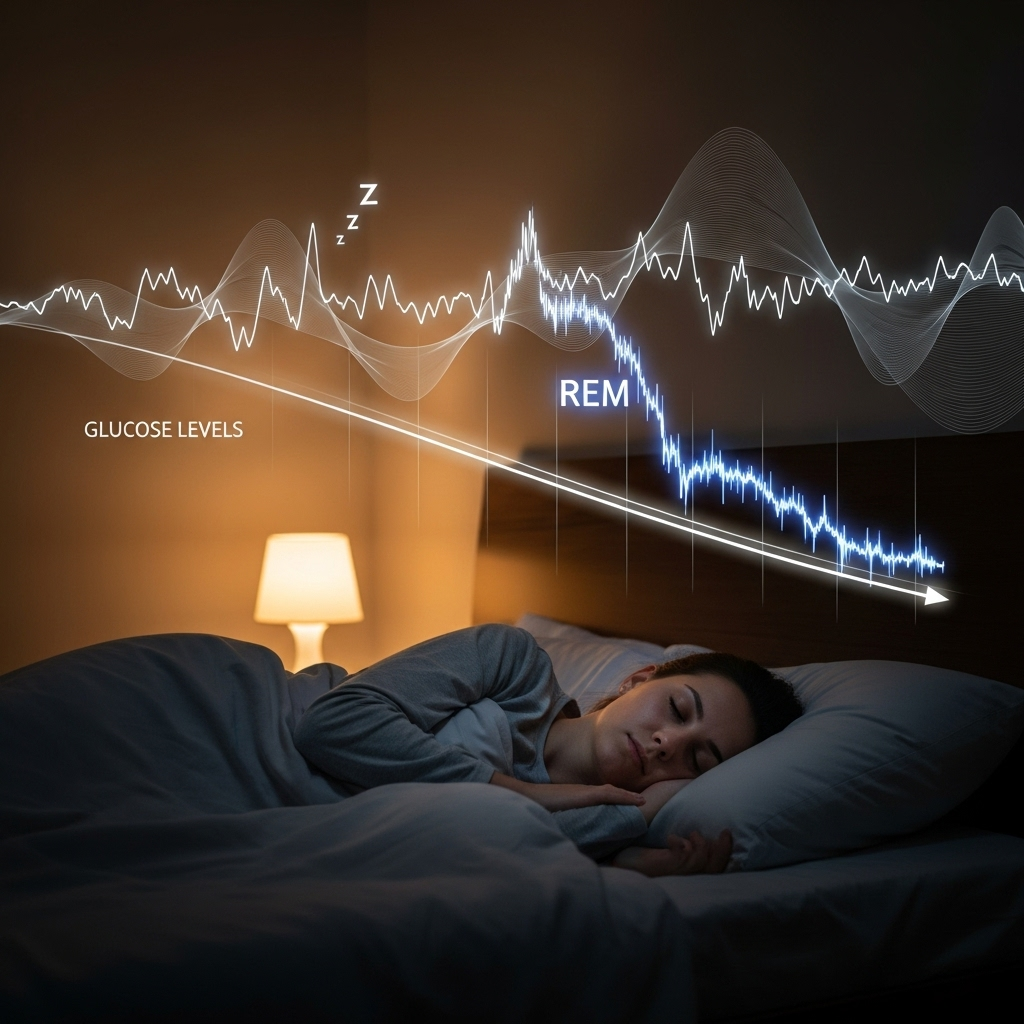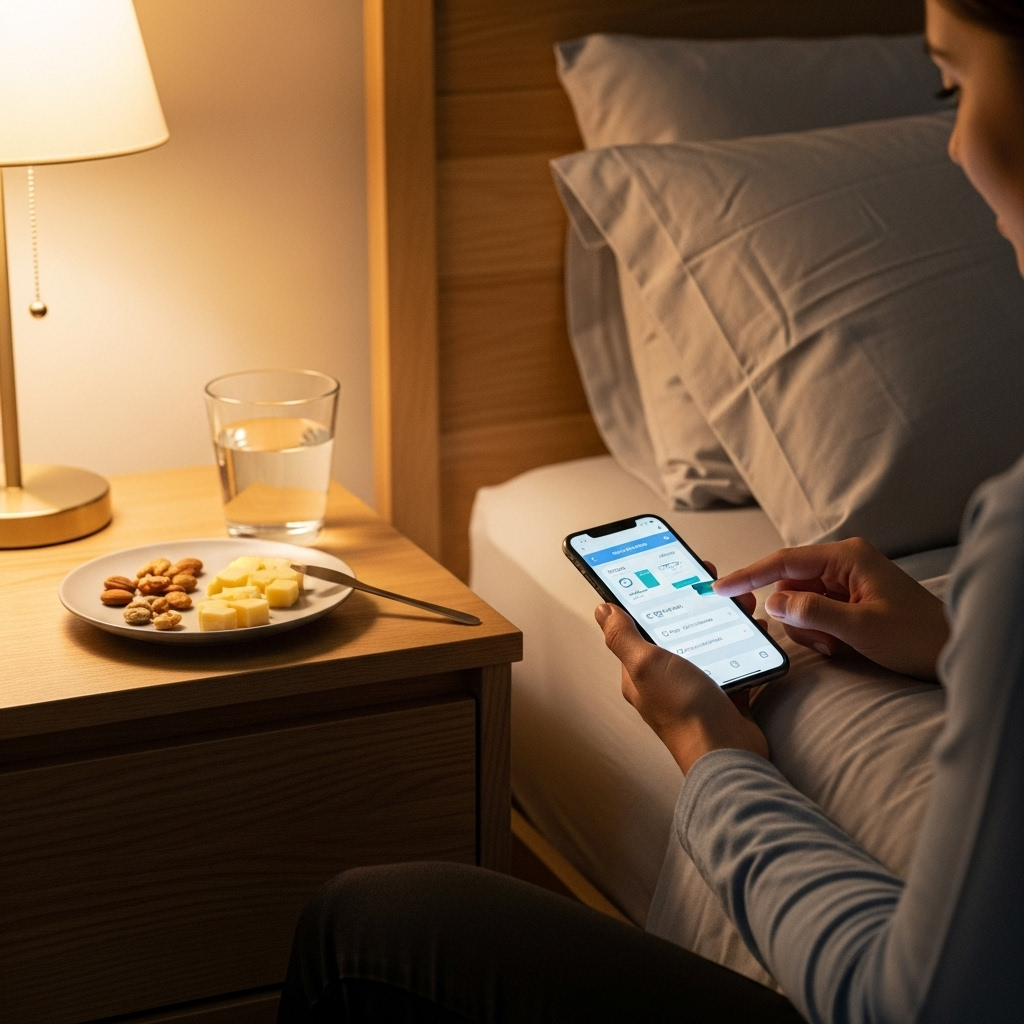As a diabetes health advocate, I've received countless messages from concerned readers who notice their continuous glucose monitors (CGMs) showing drops in blood glucose levels overnight. These patterns can be concerning, especially if you're not sure what's normal. Is your body experiencing true hypoglycemia, or could something else explain these dips? Today, I'll walk through the science behind nocturnal glucose fluctuations and help you understand what might be happening during those sleeping hours.
The Physiology of Sleep and Glucose Regulation
Our bodies follow intricate rhythms during sleep that affect multiple physiological processes, including glucose metabolism. Understanding these natural patterns can help alleviate concerns about overnight glucose readings.
REM Sleep and Glucose Dynamics
Sleep architecture consists of alternating cycles of REM (rapid eye movement) and non-REM sleep. Research shows glucose tends to decrease during REM sleep compared to non-REM phases—typically by about 5%. This natural dip is part of normal physiology and shouldn't cause alarm.

Even individuals without diabetes may experience more glucose readings below 70 mg/dL at night than during daytime hours. This doesn't necessarily indicate pathological hypoglycemia but rather reflects the body's circadian patterns of glucose regulation.
During sleep, insulin sensitivity often increases, especially in the later portions of the night. This enhanced sensitivity means the body can more effectively lower blood glucose with the same amount of insulin, which can contribute to lower readings in the early morning hours.
Extended Fasting Window Effects
Most of us experience our longest daily fasting period during sleep. If you eat dinner early (say, 6 PM) and don't eat again until breakfast (8 AM), that's a 14-hour fasting window. During extended fasting:
- Liver glycogen stores gradually deplete
- The body increasingly relies on gluconeogenesis (making new glucose) to maintain blood glucose
- Insulin levels naturally decrease, while counterregulatory hormones like glucagon help prevent true hypoglycemia
For individuals with normal glucose regulation, this system works beautifully to maintain adequate glucose levels. However, the balance might result in lower (though still safe) glucose readings by early morning.
Common Factors Behind Overnight Glucose Drops
Several factors can influence how your glucose behaves overnight. Understanding these can help you identify patterns and determine whether intervention is necessary.
Meal Timing and Composition
The timing of your evening meal significantly impacts overnight glucose levels:
- Early dinners extend your overnight fasting window, potentially leading to lower morning glucose
- Protein and fat content of dinner can affect the glucose trajectory for hours afterward
- Late-night carbohydrate snacks might prevent overnight dips but could disrupt other metabolic benefits of fasting
If you consistently see concerning overnight drops, experimenting with dinner timing or a small, balanced evening snack (including some protein and healthy fat) might be worthwhile.
The Alcohol Effect
Alcohol consumption before bed deserves special attention as it can significantly impact nocturnal glucose:
Alcohol inhibits gluconeogenesis (the liver's glucose production), which can lead to lower glucose levels, especially when:
- Glycogen stores are already low (common in those following low-carbohydrate diets)
- The person has been fasting for an extended period
- Consumption occurs without adequate food
This effect can persist for several hours after drinking, making the early morning hours particularly vulnerable to alcohol-induced glucose drops. If you notice this pattern, consider limiting alcohol consumption, ensuring you eat when drinking, or adjusting the timing to earlier in the evening.
Exercise Timing and Intensity
Exercise increases insulin sensitivity and glucose uptake by muscles. When workouts occur in the evening:
- The enhanced glucose uptake can continue for hours afterward
- Muscle glycogen replenishment takes priority
- Insulin sensitivity may remain elevated throughout the night
For those concerned about overnight lows, moving intense workouts to earlier in the day might help mitigate nocturnal drops.
Understanding CGM Artifacts vs. True Hypoglycemia
Not all overnight "lows" on your CGM represent true hypoglycemia. Understanding measurement artifacts can prevent unnecessary concern.
Pressure-Induced Sensor Errors
One of the most common sources of falsely low CGM readings at night is compression or pressure on the sensor:
- When you lie on your sensor, local blood flow to the tissue around the sensor can be reduced
- This reduced perfusion causes the interstitial glucose (what CGMs measure) to drop lower than actual blood glucose
- Movement during sleep, body position, or compression of tissue can all trigger these artifacts
These compression-induced "false lows" typically resolve quickly when you change position. You might notice a characteristic V-shaped graph pattern where glucose drops suddenly and then recovers just as rapidly once pressure is relieved.
Identifying True Hypoglycemia
For individuals concerned about true nocturnal hypoglycemia (particularly relevant for those with diabetes), important signs include:
- Glucose readings below 60-70 mg/dL that persist for extended periods
- Symptoms upon waking such as sweating, shaking, headache, or unusual fatigue
- Consistent patterns of low readings that aren't associated with sensor placement
Risk factors for true nocturnal hypoglycemia include:
- Skipping meals, especially dinner
- Evening exercise without adequate fueling
- Alcohol consumption before sleep
- Glucose-lowering medications, particularly insulin or sulfonylureas
- Concurrent illnesses or infections
Practical Strategies for Managing Overnight Glucose
Whether you're experiencing true lows or simply noticing patterns you'd like to address, several practical approaches can help optimize your overnight glucose profile.

For CGM Users
-
Track sensor placement and sleeping position: If you consistently see drops when sleeping on one side, try placing your sensor on the opposite side of your body or using different locations approved for your specific CGM model.
-
Validate suspicious readings: If you wake up to an alarming low reading, confirm with a fingerstick blood glucose test before taking corrective action.
-
Look for patterns: Use your CGM data analysis tools to identify whether drops occur at specific times of night, after certain activities, or in relation to specific meals.
Lifestyle Adjustments
-
Strategic meal timing: If overnight lows are concerning, experiment with having dinner closer to bedtime or adding a balanced snack with protein and healthy fats before sleep.
-
Alcohol awareness: Consider limiting alcohol, never drinking on an empty stomach, and ensuring adequate hydration if you choose to drink.
-
Exercise timing: For those who are particularly sensitive, consider moving intense workouts to earlier in the day, or having a strategic post-workout recovery meal to replenish glycogen stores.
For Those With Diabetes
-
Medication timing: Work with your healthcare provider to adjust timing or dosage of glucose-lowering medications if nocturnal hypoglycemia is a concern.
-
Basal insulin adjustments: For those on insulin therapy, your basal rates or long-acting insulin doses might need adjustment to account for overnight sensitivity.
-
Regular monitoring: Keep track of patterns and share them with your healthcare team to inform treatment decisions.
Remember, some glucose variation overnight is completely normal, even beneficial, reflecting the body's natural rhythm and fasting state. The goal isn't perfectly flat glucose lines but rather patterns that support overall health and avoid extreme fluctuations.
Conclusion
Overnight glucose drops can be a source of concern for CGM users, but understanding the physiological, behavioral, and technical factors behind these patterns can provide reassurance and guide appropriate action.
For most people without diabetes, mild overnight dips are part of normal physiology tied to sleep cycles, fasting, and circadian rhythms. For those with diabetes or metabolic concerns, recognizing the difference between CGM artifacts and true hypoglycemia is crucial for appropriate management.
By paying attention to meal timing, alcohol consumption, exercise patterns, and sensor placement, you can develop a personalized approach to optimizing your overnight glucose profile while gaining valuable insights from your CGM data.
References:
Rybicka M, Krysiak R, Okopień B. The dawn phenomenon and the Somogyi effect - two phenomena of morning hyperglycaemia. Endokrynol Pol. 2011;62(3):276-284.
Juvenile Diabetes Research Foundation Continuous Glucose Monitoring Study Group. Effectiveness of continuous glucose monitoring in a clinical care environment: evidence from the Juvenile Diabetes Research Foundation continuous glucose monitoring (JDRF-CGM) trial. Diabetes Care. 2010;33(1):17-22. doi:10.2337/dc09-1502






